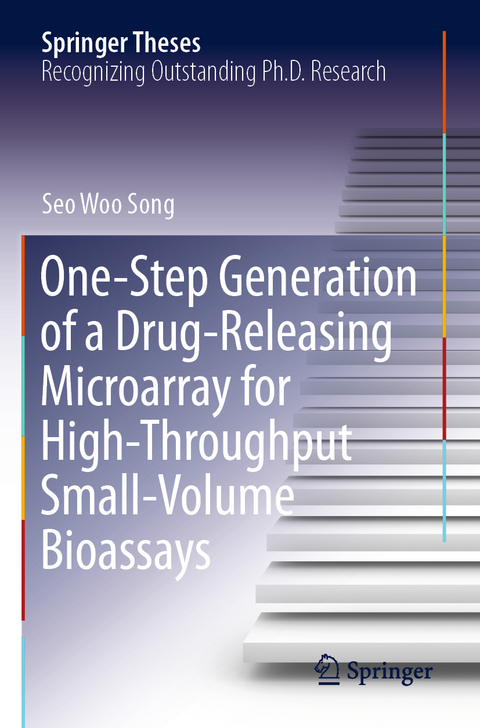
One-Step Generation of a Drug-Releasing Microarray for High-Throughput Small-Volume Bioassays
Springer Verlag, Singapore
978-981-13-8096-9 (ISBN)
In this thesis, the author firstly describes the need and concept of ‘partipetting’ for pipetting-free HTS platform. It is realized by the one-step pipetting and self-assembly of encoded drug-laden microparticles (DLPs) on the microwells. Next, the technical implementations required for the platform demonstration are described. It includes preparation of encoded DLPs, plastic chip fabrication, andrealization of automated system. Lastly, screening of sequential drug combinations using this platform is demonstrated. This shows the potential of the proposed technology for various applications.
Seo Woo Song earned PhD degree in the department of electrical and computer engineering from Seoul National University, Republic of Korea in 2019. His research interests are lab on a chip, bioMEMS, and micro-robotics.
Abstract.- Table of Contents.- List of Tables.- List of Figures.- Chapter 1. Introduction.- 1.1. High-Throughput Small-Volume Bioassays.- 1.2. Developmental Goal for the ‘Pipetting-Free’ HTS Platforms.- 1.3. Main Concept: One-Step Generation of a Drug-Releasing Microarray-on-a-Chip by Self-Assembly of Drug-Laden Microparticles (DLPs).- Chapter 2. System Development.- 2.1. Sealing-Film Assisted Seeding Method for Saving Cell Consumptions.- 2.2. Chip and Jig Development.- 2.3. Preparation of DLPs Library.- 2.4. Decoding Microparticles.- 2.5. Statistical Analysis for Duplications.- Chapter 3. Application: Screening of Sequential Drug Combinations.- 3.1. Therapeutic Benefit of Sequential Drug Combination Based on Rewiring of Intracellular Pathways.- 3.2. Screening of Sequential Drug Combination Using a Partipetting Platform.- 3.3. Proof-of-Concept: Sequential Combinatorial Cell Staining Assay by Replacement of the Drug Chip.- 3.4. Screening of Sequential Combinatorial Drugs with EGFR Inhibitor Followed by Genotoxin against Triple Negative Breast Cancer (TNBC).- Chapter 4. Conclusion and Discussion.- Bibliography.
| Erscheinungsdatum | 07.07.2020 |
|---|---|
| Reihe/Serie | Springer Theses |
| Zusatzinfo | 40 Illustrations, color; 6 Illustrations, black and white; XXI, 52 p. 46 illus., 40 illus. in color. |
| Verlagsort | Singapore |
| Sprache | englisch |
| Maße | 155 x 235 mm |
| Themenwelt | Mathematik / Informatik ► Informatik ► Theorie / Studium |
| Medizin / Pharmazie ► Physiotherapie / Ergotherapie ► Orthopädie | |
| Studium ► 2. Studienabschnitt (Klinik) ► Humangenetik | |
| Naturwissenschaften ► Biologie | |
| Naturwissenschaften ► Physik / Astronomie ► Thermodynamik | |
| Technik ► Medizintechnik | |
| Schlagworte | Drug releasing • Encoded drug -laden microparticles • High-throughput screening • microarray • Microarray-On-A-Chip • Microparticles |
| ISBN-10 | 981-13-8096-1 / 9811380961 |
| ISBN-13 | 978-981-13-8096-9 / 9789811380969 |
| Zustand | Neuware |
| Informationen gemäß Produktsicherheitsverordnung (GPSR) | |
| Haben Sie eine Frage zum Produkt? |
aus dem Bereich


